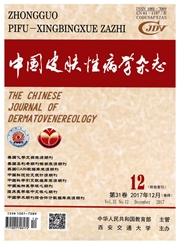

 中文摘要:
中文摘要:
目的探讨中药退白颗粒联合窄谱中波紫外线(NB—UVB)治疗寻常型白癜风的『临床疗效,同时检测联合疗法治疗前后对患者血清T细胞亚群及粒细胞一巨噬细胞集落刺激因子(GM—CSF)表达水平的影响和临床意义。方法选取60例寻常型白癜风患者,给予中药退白颗粒内服联合NB-UVB皮损局部照射治疗,疗程为3个月,观察患者临床疗效;另选志愿者30例作为健康对照组。采用流式细胞仪和放射免疫分析仪分别对健康对照组及白癜风患者治疗前后血清中CD4+、CD8+T及GM.CSF表达水平进行检测。结果进展期有效率88.24%与稳定期61.54%、皮损面积〈5%87.10%与≥5%65.52%、病程〈1年87.50%与≥1年64.29%分别配对比较,差异均有统计学意义(P均〈0.05);进展期CD4+T水平、CD4+/CD8+比值和稳定期CD4+T水平以及皮损面积〈5%和≥5%、病程〈1年和≥1年CD4+T水平、CD4+/CD8+比值与治疗前比较均明显上调(P〈0.050rP〈0.01);进展期CD8+T、GM—CSF水平和稳定期GM—CSF水平以及皮损面积〈5%和≥5%、病程〈1年和≥1年CD8+T、GM—CSF水平与治疗前比较均明显下调(P〈0.050rP〈0.01)。结论CD4+、CD8+T及GM—CSF表达水平异常及CD4+/CD8+比值失衡可能参与了寻常型白癜风的发病,中药退白颗粒联合NB—UVB可能通过调节T细胞亚群、GM—CSF的表达水平并纠正CD4+/CD8+失衡状态对该病发挥治疗作用。
 英文摘要:
英文摘要:
Objective To research the clinical efficiency of traditional chinese medicine Tuibai granules combined with narrow band UVB ( NB-UVB ) in the treatment of viti]igo vulgafis, and detect the influence and clinical significance on the expression levels of T cell subsets and granulocyte-macrophage colony stimulating factor (GM-CSF) of serum before and after the combined treatment. Methods Sixty cases of patients were treated with Tuibai granules orally combined with NB-UVB local radiation for 3 months, and observing the clinical efficiency. Another 30 cases of volunteers were chosen as healthy control group. The expression levels of CD4+, CD8 +T and GM-CSF were detected in healthy control group and patients before and after the treatment by flow cytometry and radioimmunoassay. Results Efficiency rate in progressive period was 88.24% and 61.54% in stable period, 87. 10% in the skin lesion area 〈 5% and 65.52% in the lesion area+〉5% , 87.50% in disease course 〈 1 year and 64. 29% in disease eourse+〉l year. The differences of above index compared in pair respectively were all statistically significant ( all P 〈 0. 05 ). The expression levels of CD4+ T and the ratio of CD4 +/CD8 + in progressive period, and the expression levels of CD4+ T in stable period, and the expression levels of CD4 +T and the ratio of CD4 +/CD8 + in skin lesion area 〈 5% and t〉5%, in disease course 〈 1 year and ≥lyear, were all up regulated significantly compared with that before the treatment ( P 〈 0. 05 or P 〈 0. 01 ). The expression levels of CD8 + T, GM-CSF in progressive period, and the expression level of GM-CSF in stable period, and the expression levels of CD8+T, GM-CSF in skin lesion area 〈5% and ≥5%, in disease course 〈 1 year and≥1 year, were all down regulated significantly compared with that before the treatment (P 〈 0. 05 or P 〈 0. 01 ). Conclusion Abnormal expression levels of CD4+, CD8+ T and GM-CSF, and imbalance ratio of CD4+/CD8
 同期刊论文项目
同期刊论文项目
 同项目期刊论文
同项目期刊论文
 期刊信息
期刊信息
